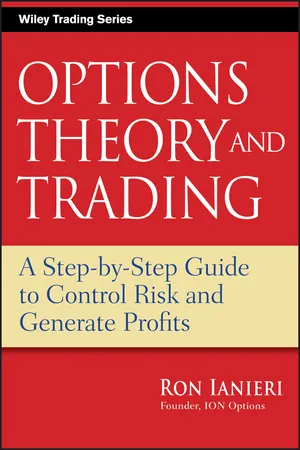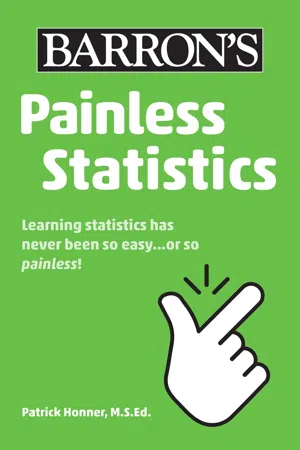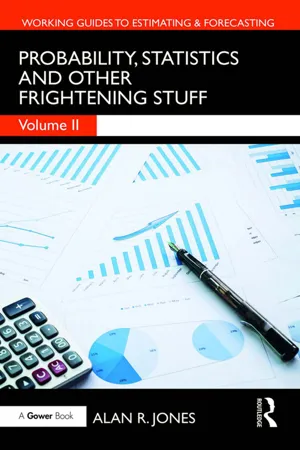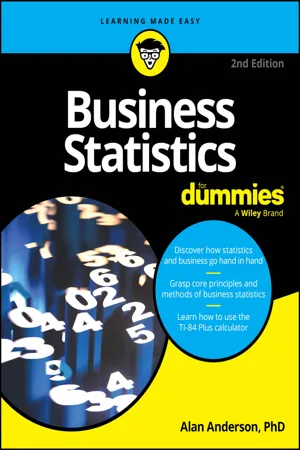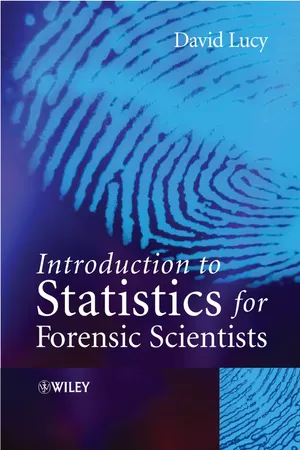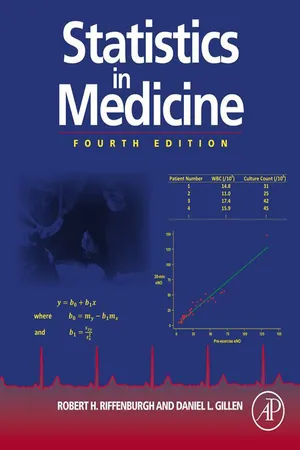Psychology
Normal Distribution Psychology
The normal distribution in psychology refers to a bell-shaped curve that represents the distribution of many psychological traits and behaviors in the population. It is characterized by a symmetrical shape with the majority of scores falling near the mean and fewer scores at the extremes. This distribution is important for understanding and analyzing various psychological phenomena and measurements.
Written by Perlego with AI-assistance
Related key terms
Related key terms
1 of 4
Related key terms
1 of 3
10 Key excerpts on "Normal Distribution Psychology"
- eBook - ePub
Options Theory and Trading
A Step-by-Step Guide to Control Risk and Generate Profits
- Ron Ianieri(Author)
- 2009(Publication Date)
- Wiley(Publisher)
The term normal distribution (bell curve) does not really signify the perfect shape of the bell. What it signifies is a family of different distributions that are evenly dispersed around the mean. Evenly dispersed indicates that a bell curve must be symmetrical (each side of a central dividing line is identical to the other). That is important because if the curves are not symmetrical, they are not a normal distribution; this is going to be a major distinction later because the majority of the pricing models are based on normal distributions. If stock returns are normally distributed, then these models will work perfectly. However, if stock returns aren’t normally distributed, then these models are not going to be very accurate. They might be relatively accurate. They might even be very accurate, but they will not be perfectly accurate. And in certain instances, that can hurt you. Later we are going to talk about what those instances are and how we can adjust for them. But for right now, a normal distribution is any family of distributions that is symmetrical. Normal distributions are broken down by the bell curve into three standard deviations: three to the right and three to the left. A standard deviation (distance from the mean) is a statistical measure that tells you how tightly a group of examples in a sample are clustered around the average or mean. A standard deviation is a measure of spread or dispersion. FIGURE 3.2 Two Normal Distributions Since there is only a 100 percent chance of anything happening, the bell curve encompasses all of the possibilities—all the possible outcomes. The curve gives the percentage chance of potential outcomes occurring. Obviously, there is a mean or average that is core to the distribution model of the bell curve. However, what we are most concerned with seeing when we look at normal distribution (the bell curve) is how the distribution is dispersed, creating our probabilities. Figure 3.3 shows a bell curve - Rachad Antonius(Author)
- 2012(Publication Date)
- SAGE Publications Ltd(Publisher)
Figure 6.1 shows the curve of a normal distribution.Normal distributions can be described by the descriptive measures that we have seen so far. They are characterized by the following properties:Figure 6.1 The basic shape of the normal curve- They are symmetric and unimodal (i.e. they have a single mode), which means that the two halves of the distribution are mirror images of each other and that their mean, mode and median are identical.
- The graph that represents them is a bell-shaped curve.
- The distribution can be completely described if we know that it is normal, and if we know its mean and standard deviation. For this reason, normal distributions are denoted by the symbols N (μ, σ). The N tells us we are talking about a normal distribution, the μ is the mean of the distribution and the σ is its standard deviation.
The equation gives the y-value (the height) of N(0, 1), that is, a normal curve with mean equal to 0 and standard deviation equal to 1, as shown in Figure 6.1 .Properties of Normal Distributions
Normal distributions often occur when a quantitative variable is distributed at random. For instance, if we choose a random sample of, say, 3000 men and we draw the distribution of their heights, we are likely to find the pattern of a normal distribution shown above.They can be thought of as a smooth line that runs along the top of a histogram that has a very large number of very narrow columns. Figure 6.2- eBook - ePub
- Patrick Honner(Author)
- 2022(Publication Date)
- Barrons Educational Services(Publisher)
Chapter 5 The Normal DistributionStatistics is an applied science, so once you understand the basics of statistics, you’ll want to apply what you’ve learned. You’ll look around in the world and see data—times, prices, populations, ages, revenues—and you’ll use your knowledge of statistics to make sense of it.Data in the real world comes in many shapes and many distributions; you were introduced to many different distributions in Chapter 4 . However, when it comes to data in the real world, one of the most common, and useful, shapes is the normal distribution.Normally Distributed Data The Shape of the Normal DistributionThe normal distribution is a continuous data distribution that looks like this:Figure 5–1. The Normal DistributionAs you can see from the above graph, the normal distribution is symmetric and unimodal. It’s symmetric because you can draw a line down the middle and see the same shape of data on either side. It’s unimodal because the graph of the data has only one peak, which means there is only one mode.The normal distribution is also known as the Gaussian distribution, after the mathematician Carl Friedrich Gauss.Many kinds of real-world data, from characteristics like height to performance indicators like test scores, are distributed in a way that is approximately normal. Here’s what a histogram of data that is approximately normal might look like:Figure 5–2. Histogram of Data that is Approximately NormalYou can see that this histogram shares a similar shape to the graph of the normal distribution. It’s possible to find a continuous normal curve that closely fits this data, which means you can approximate this discrete data with a continuous normal distribution.Figure 5–3. Histogram with Approximating Normal CurveMeasures of Central Tendency and Standard Deviation for the Normal DistributionThe ability to approximate data using the normal distribution makes it a very powerful and useful statistical tool. When you encounter real-world data that is approximately normal, you can model it with a continuous normal distribution and then apply everything you know about the normal distribution to your data. Since the normal distribution is symmetric and unimodal, it can be understood with just a few numbers. The mean, median, and mode are all the same; that is, a single center of the data splits the data into two parts that are mirror reflections of each other. This is one reason why normal distributions are easy to work with. - Alan Jones(Author)
- 2018(Publication Date)
- Routledge(Publisher)
We will see that this is the case with many of the ‘named’ distributions.) In order to differentiate one Normal Distribution from another we need to specify two parameters that define its location along the x-axis and a Scale Parameter that indicates its effective width or dispersion. We express the location in terms of the mean value (µ) and its scale or width by the Standard Deviation (σ).The Normal Distribution is characterised chiefly by its symmetrical ‘bell-shaped’ Probability Density Function around its mean. Figure 4.5 illustrates two different Normal Distributions. The one on the left has a low Mean value with a small (tight) dispersion around it. The one on the right looks as if someone has pulled it and sat on it, giving it a large (wide) dispersion around a larger Mean.Figure 4.5Two Normal DistributionsIn this example we should note that the Probability Density of the left-hand distribution’s mode is twice that of the right-hand one, whereas the ‘effective’ width of the one on the right (two to eight) is twice that of the one on the left (one to four). This effective width is equal to six times the Standard Deviation of each distribution. (Note that in an absolute sense both distributions tend towards infinity in either direction.) This leads us to one of the most important properties of a Normal Distribution – the integrity of its relative shape . . .4.2.2 Key properties of a Normal Distributiona) Scalable and slidable
As well as being a symmetrical distribution, which implies that its Arithmetic Mean, Mode and Median are all equal, the most important property of a Normal Distribution is that the dispersion of its values around the Mean differs only in direct proportion to its Standard Deviation. For any Normal Distribution, regardless of the values of its Mean or Standard Deviation, we can say that the following will always be true:- There is a 68.27% Confidence Interval formed by a range of one Standard Deviation either side of the Mean (i.e. just over two-thirds of our distribution is packed into the space around the Mean, and just under one third lies outside this range with one sixth on either side being symmetrical
- eBook - ePub
- Alan Anderson(Author)
- 2023(Publication Date)
- For Dummies(Publisher)
all values between negative infinity and positive infinity.In the following sections, I show you how you can express the normal distribution graphically, I introduce you to the standard normal distribution, and I walk you through calculating probabilities for the normal distribution.Graphing the normal distribution
The normal distribution can be graphed with a special type of curve, which is usually described as a bell-shaped curve. Normal probabilities can be determined by computing areas under this curve.The bell-shaped curve has several key features. It’s defined over the entire range of values between negative and positive infinity; it’s symmetrical about the mean (for example, the area below the mean is a mirror image of the area above the mean); and most of the area under the normal distribution is close to the mean. The area declines rapidly for values that are several standard deviations away from the mean. As an example, the distribution of heights from the previous example is illustrated with a bell-shaped curve in Figure 9-1 .The mean of 69 inches is at the center of the distribution; the area to the left of the mean is a mirror image of the area to the right of the mean. Most of the area under the curve is close to the mean; the area falls off rapidly for large and small values of X. (The extreme right and left ends of the curve are known as the tails of the distribution.) Figure 9-2 shows that the probability of a randomly chosen man’s height being between 67 inches and 71 inches is 68.27 percent.The shaded region under the curve represents heights between 67 and 71 inches. This covers 68.27 percent of the area under the curve; therefore, the probability that a randomly chosen man’s height is between 67 inches and 71 inches is 0.6827 or 68.27 percent. - eBook - ePub
Statistics for the Behavioural Sciences
An Introduction
- Riccardo Russo(Author)
- 2004(Publication Date)
- Psychology Press(Publisher)
σ = 15. The percentages indicate the portion of the total area under the normal distribution between two IQ values (e.g., 13.6 per cent of the total area under the normal distribution is between the IQ values of 70 and 85, inclusive).While the distribution is always bell shaped and symmetrical around the mean, different values of the parameters affect the appearance of the distribution. Changes in μ produce shifts of the entire distribution along the x-axis (i.e., the distribution is centred around different mean values), while changes in σ2 , or equivalently in σ, correspond to changes in the scale of measurement and affect the peak of the distribution and its spread around the mean. With small standard deviations, the peak of the distribution tends to be high and the main body of the bell tends to be narrow, while with large standard deviations, the peak tends to be low and the main body of the bell tends to be wide.We said earlier that areas under a continuous distribution, between two values of the random variable X, correspond to probabilities. We also gave the size of the areas of some portions of the normal curve shown in Figure 5.3. Any area under a curve is obtained by calculating the integral, over a range of values of the random variable X, of the function describing the continuous distribution. However, you do not have to worry about the process of integration to calculate probabilities for the most important continuous distributions, because these probabilities are provided in tables. In the case of the normal distribution, a table of probabilities is available for the special case where μ = 0 and σ2 = 1 (see Table 5.1 and the more comprehensive Z table in the Appendix). A normal distribution with these parameters is called the standard normal distribution. The next section will describe this distribution.The standard normal distribution
In the last section of Chapter 2 we presented some transformations that can be applied to a set of data. In particular we said that when the mean is subtracted from each score and this difference is divided by the standard deviation of the distribution of the scores, we obtain a new standardised score named z - Martin Lee Abbott(Author)
- 2014(Publication Date)
- Wiley(Publisher)
7
THE NORMAL DISTRIBUTION
Thus far, we have discussed how to describe distributions of raw scores graphically and in terms of central tendency, variability, skewness, and kurtosis. We will continue to perform these calculations because most all of the statistical procedures we will discuss in subsequent chapters require that data be normally distributed. Using what we have learned with calculating these descriptive statistics, we can confirm whether our data are normally distributed or if we must use different procedures. Often, even if the variables are not strictly or exactly normally distributed, we can still use them because many statistical procedures are ‘‘robust’’ or able to provide meaningful and precise results even if there are some violations of the normal distribution assumptions.THE NATUREOFTHE NORMALCURVE
The normal distribution, as I explained in an earlier chapter, is very common in educational research, so we need to deepen our understanding of some of the properties of the normal curve. I call the normal distribution a curve because the histogram forms a curve when the top midpoints of the bars are joined together. Technically, this is called a frequency polygon . If you look back to Figure 5.25 , you will see the SPSS® histogram for the school-based math achievement variable we discussed. In the figure, SPSS® overlaid the normal curve on top of the histogram so you can see the extent to which the data approximate a normal distribution. As you can see from that figure, if you were to connect the top midpoints with a line, it would not be the smooth line you see, but rather a more jagged line. However, as a database increases its size, the histogram approximates the smooth normal curve in variables that are normally distributed; the jagged line becomes filled in as more cases are added.When we speak of the normal distribution and how our sample dataset is normally distributed, we actually speak about our data approximating a normal distribution. We refer to the perfect normal distribution as an ideal so that we have a model distribution for comparison to our actual data. Thus, the normal curve is a kind of perfect ruler with known features and dimensions. In fact, we can mathematically chart the perfect normal curve and derive a picture of how the areas under the curve are distributed. Because of these features, we refer to the perfect normal distribution as a standard normal distribution.- eBook - ePub
Researching Education
Perspectives and Techniques
- Kanka Mallick, Gajendra Verma(Authors)
- 2005(Publication Date)
- Routledge(Publisher)
It can be seen that the tops of the columns lie approximately on a curve and that the area under the curve is equivalent to that of the columns. However, to obtain the probability of 8 or more heads by using the curve we need to obtain the area under the tail of the curve from 7.5 to 10.5. Since tables of areas under the normal curve are obtainable in books, they are often used to obtain probabilities in large distributions.Figure 8.2: Normal distribution and the 10-coin testAlthough laborious, it would be possible to work out the probabilities if 100 coins were tossed together. If the result were represented in a column graph, the tops of the columns would form an almost perfect curve known as the ‘normal curve’.Many distributions of measurements of human beings such as heights, weights, sizes of shoes, gloves or hats, the distances individuals of the same age and sex can throw a ball, and so on, fit very well to the normal curve. So do many educational and psychological test scores, although in the case of standardized tests, this may be partly because educationists and psychologists designed them to do so. Before we can make use of the normal curve in order to say how exceptional a pupil’s score is as compared with other children of the same age, we need to turn his or her score in a test into a standard score. To do this we must first obtain the mean and standard deviation for the distribution of scores.Taking a simplified example initially: in six tests, a boy obtains marks of 36, 49, 52, 60, 65, 74. The mean (or average) score is defined as the total of the scores for all the tests divided by the number of tests, i.e. the boy’s mean score is .Deviations of the scores above and below the mean are as follows:Score 52 49 65 36 60 74 Deviation from 56 -4 -7 9 -20 4 18 Total=0 Having obtained the variance by squaring the deviation (which gave us 147.67 in this example) the ‘standard deviation’ is arrived at by finding the square root of 147.67 which is approximately 12.2. It is now possible to arrive at the ‘standard score’ in each subject by using the formula - David Lucy(Author)
- 2013(Publication Date)
- Wiley(Publisher)
4 The normal distribution In Section 3.2 we saw how the binomial distribution could be used to calculate probabilities for specific outcomes for runs of events based upon either a known probability, or an observed probability, for a single event. We also saw how an empirical probability distribution can be treated in exactly the same way as a modelled distribution. Both these distributions were for discrete data types, or for continuous types made into discrete data. In this section we deal with the normal distribution, which is a probability distribution applied to continuous data. 4.1 The normal distribution The normal distribution † is possibly the most commonly used continuous distribution in statistical science. This is because it is a theoretically appealing model to explain many forms of natural continuous variation. Many of the discrete distributions may be approximated by the normal distribution for large samples. Most continuous variables, particularly from biological sciences, are distributed normally, or can be transformed to a normal distribution. Imagine a continuous random variable such as the length of the femur in adult humans. The mean length of this bone is about 400 mm, some are 450 mm and some are 350 mm, but there are not many in either of these categories. If the distribution is plotted then we expect to see a shape with its maximum height at about 400 mm tailing off to either side. These shapes have been plotted for both the adult human femur and adult human tibia in Figure 4.1. The tibia in any individual is usually shorter than the femur, however, Figure 4.1 tells us that some people have tibias which are longer than other people’s femurs. Notice how the mean of tibia measurements is shorter than the mean of the femur measurements- eBook - ePub
- Robert H. Riffenburgh, Daniel L. Gillen(Authors)
- 2020(Publication Date)
- Academic Press(Publisher)
The distribution is just a rectangle. The bell curve has a graph showing a central hump (mode) with observations tailing off symmetrically, or approximately so, on either side. The normal is a bell curve with certain additional characteristics that are noted in Sections 4.7 and 6.2. In describing the shape of a distribution, we look for what might be called smoothness. A “well behaved” distribution has a single clearly seen mode, tails off in not too jagged a fashion on either side, and relates in a meaningful way to the variable of interest. Then we look for symmetry. If one tail is “dragged out” more than the other, we say that the distribution is skewed in that direction. We look for the approximate center of the distribution. In a unimodal unskewed (symmetric) curve the mode, median, and mean will coincide. If it is right skewed, the median is to the right of the mode and the mean is to the right of both. Finally, we look to see how much it is spread out about its center, that is, its approximate standard deviation. By examining the distribution in this fashion, we can get a much clearer picture of what forces are at work in the generation of the data than through knowing only the mean and the standard deviation. Example: Prostate volumes from DB1 Fig. 4.2 shows the frequency distribution of 301 prostate volumes from Fig. 3.3F with the population probability distribution approximated by a freehand fit. Note that it is skewed to the right. In agreement with this, the mean of 36.5 mL is to the right of both the median (32.4 mL) and the mode (32.5 mL). Before seeing any data, we might have expected a symmetric distribution. Some of the skew seems to arise from the presence of benign prostatic hypertrophy (BPH), which causes a large increase in prostate volume. However, we suspect the main cause is the limitation on the left by zero, whereas there is no limitation to the right
Index pages curate the most relevant extracts from our library of academic textbooks. They’ve been created using an in-house natural language model (NLM), each adding context and meaning to key research topics.
Explore more topic indexes
Explore more topic indexes
1 of 6
Explore more topic indexes
1 of 4
